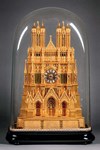
The early 17th century astronomical watch by Thomas Chamberlain quadrupled its guide at Schloss Ahlden to sell for €24,000 (£20,870).
The auction market for watches in Germany and Switzerland is still very much in the hands of wristwatch aficionados, who regularly bid six-figure prices.
Currently pocket watches rarely reach these heights and certainly come nowhere near the $5.1m recently bid at Phillips in Hong Kong for an admittedly extremely rare Patek Philippe wristwatch which once belonged to the last emperor of China.
Nonetheless, as recent sales have shown, noteworthy results can still be achieved for pocket watches. Bidders, however, can afford to be choosy and ignore pieces that are not perfect or that are overpriced.
It is not always easy to sell early watches. There are sometimes doubts about their authenticity, but when technical quality, condition and provenance come together, bidders will be on hand to ensure a good sale.
London maker
Among the pieces on offer at Schloss Ahlden (25% buyer’s premium) near Hanover on May 6, was an astronomical watch by the London maker Thomas Chamberlain from c.1630.
It was reputedly given by King Charles II to the writer, bibliophile and horticulturalist John Evelyn and later belonged to the Harcourt family collection. The moderate estimate of €6000 inspired dealers and collectors from home and abroad.
A European collector saw off his competitors at €24,000 (£20,870).
Work of Quare
At Sotheby’s (27% buyer’s premium) sale in Geneva on May 14, a late 17th century clock-watch was knocked down for SFr28,000 (£24,780), a bit below the guide of SFr30,000.
The large silver pair cased quarter-repeating two-train coach watch with alarm was the work of Daniel Quare, the case of which was engraved with the arms of the Duke of Luxembourg and could be dated to 1690.
Ten years previously, Quare had begun developing a repetition mechanism, another pioneering achievement, although there is some debate about whether he or his contemporary William Barlow was the true innovator.
Across the Channel at about the same time, Pascal Huber à Rouen built a large silver clock-watch with hour striking and a verge movement without a fusee. It changed hands on May 14-15 in a sale at Antiquorum (25/20% buyer’s premium) in Geneva for a mid-estimate SFr12,000 (£10,620).
Major manufacturing centre
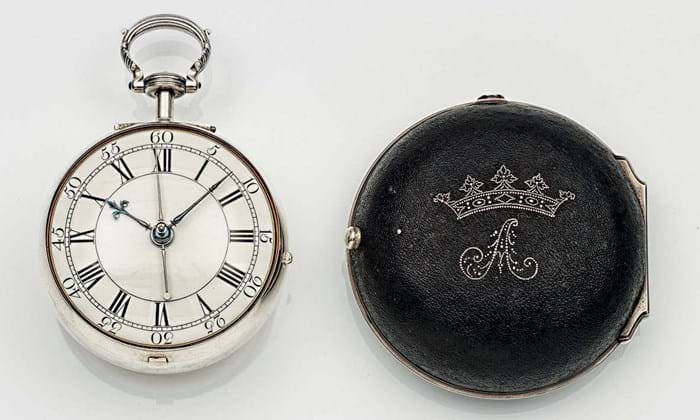
To attract foreign customers, the German maker Joseph Spiegel signed the movement of this clock-watch Miroir à Paris. It sold at Dr Crott in Mannheim for €33,000 (£28,700).
For much of the 18th century, the Bavarian town of Friedberg near Augsburg was a major centre for the production of clock-watches.
Among the renowned makers was Joseph Spiegel who made a quarter-striking and repeating coach watch with alarm mechanism and date aperture, which sold to a Swiss bidder at Dr Crott (25% buyer’s premium) on May 20 in Mannheim for €33,000 (£28,700), considerably above the upper estimate.
Thinking that he would find a better market in France, Spiegel, whose name translates as mirror, signed this piece with Joseph Miroir à Paris.

Father and son Daniel und Thomas Grignion made this mid-18th century coach-watch with a shagreen outer case which sold at Schloss Ahlden for €14,000 (£12,175).
A mid-18th century coach-watch with a shagreen outer case by father and son Daniel and Thomas Grignion in London changed hands at Ahlden for €14,000 (£12,175), doubling the upper guide. This time, an international dealer was successful. The vendor had purchased it from the British dealer Ronald A Lee in 1971.
Breguet brilliance
Abraham Louis Breguet is considered by many to have been the most accomplished of all watchmakers.
His timekeepers are aesthetically and technically remarkable; he was responsible for countless pioneering horological developments.
Demand is fairly consistent and from time to time, the Breguet Museum joins the action to add important pieces to its collection.
Thanks to the extensive company archives, it is possible to trace the provenance of many watches back to their original illustrious purchasers.

A highly complicated masterpiece by Abraham Louis Breguet, sold in 1808 to an Ottoman ambassador, changed hands at Sotheby’s in Geneva for SFr800,000 (£707,965).
The top lot in this report and the highest price for a pocket watch achieved thus far in Europe this season was a so-called cabriolet clock watch which was sold to the Ottoman Ambassador to France, Esseid Ali Effendi, in 1808.
Over the years he was a regular purchaser at Breguet’s workshop.
The inner case can be reversed inside the outer case to reveal the highly decorated inner case back, hence the term ‘cabriolet’. The highly decorated case contains as many refined elements as Breguet could fit in such a confined space, including grande and petite sonnerie, independent minute repetition and five hammers striking on five gongs.
Sotheby’s considered this to be the most complex movement Breguet created for the Ottoman market and the bidders were obviously inclined to agree.
They pushed the price from the estimated SFr500,000 to SFr800,000 (£707,965).
When, according to the company records, Monsieur Frédéric Frackmann purchased a gold-dialled souscription watch from Breguet in 1805, he was given a discount of 60 Francs, paying 984 Francs.
There was no such reduction for the buyer at Christie’s (26/21/15% buyer’s premium) in Geneva on May 13: their final bid of SFr80,000 (£70,800) was four times the guide.
A gold watch with offset seconds dial, an unusual variation of Breguet’s so-called montre simple, from 1801, doubled the estimate to sell at Christie’s for SFr40,000 (£35,400).
However, no takers emerged for a magnificent and very rare self-winding watch with minute repeating and power reserve indication, completed in the 1790s. Even though it still had its original dial and had once, for what it’s worth, belonged to great-great-great-great-grandfather of Diana, Princess of Wales, no one was prepared to part with SFr300,000.
A quarter-repeating mechanism was not an uncommon feature of a Breguet watch, but a jumping hour hand was more unusual.
It presumably contributed to the interest for a gold watch from 1807 that was knocked down at Dr Crott for a mid-estimate €30,000 (£26,090).
On November 8, 1842, ‘Monsieur le Prince Lubomirsky’ bought an open face, Lepine-calibre gold watch from Breguet in Paris for 1200 Francs. Schloss Ahlden priced it at €3600, but it now sold it to an Asian buyer for €11,000 (£9565).
Technical innovation
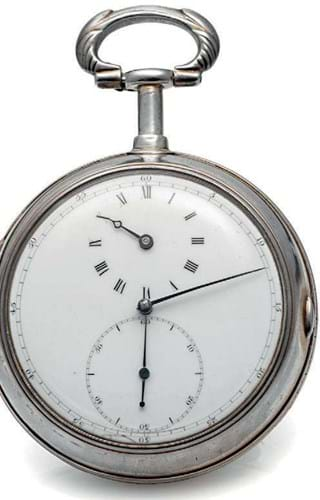
Originally signed for Josiah Emery, this silver watch with regulator dial was the work of Richard Pendleton. At Antiquorum in Geneva it went to a collector for SFr34,000 (£30,090).
The late 18th and early 19th centuries were a period of immense technical innovation, with watchmakers throughout Europe striving to improve the precision and the technical finesse of their timekeepers.
A rare, late 18th century silver watch with lever escapement, helical balance spring and regulator dial was the work of Richard Pendleton who is known to have created the movements of similar watches for Josiah Emery.
This watch was one such piece as can be seen by the fact that the dial was originally signed for Emery London. Only faint traces of the signature remain and at Antiquorum Pendleton received the credit due to him, in the shape of a closing bid from a Swiss collector of SFr34,000 (£30,090).
Royal watchmaker
Of Swiss origin, Daniel de St Leu made a name for himself in London, becoming royal watchmaker in 1765. His pair-cased verge watch with quarter-hour self-striking and chatelaine, doubled its lower guide at Cortrie (21% buyer’s premium) in Hamburg on May 6 to sell for €10,000 (£8965).

Built for an explorer c.1800, this unsigned watch with four time zones was bought by an Asian dealer at Antiquorum for SFr38,000 (£33,630), almost four times the guide
Around 1800, an unknown Swiss maker built an explorer’s watch with verge escapement, subsidiary dials for four time zones, date and – an unusual feature – a compass on the reverse. It attracted a lot of attention at Antiquorum and sold to an Asian dealer for SFr38,000 (£33,630), almost four times the guide.
Interesting pieces could sometimes be picked up for moderate prices such as a gold watch from 1811, signed Vulliamy, a member of the famous London watchmaking family. The movement was fitted with a duplex escapement and a large monometallic balance wheel. It was knocked down at Cortrie for a low-estimate €3500 (£3045).
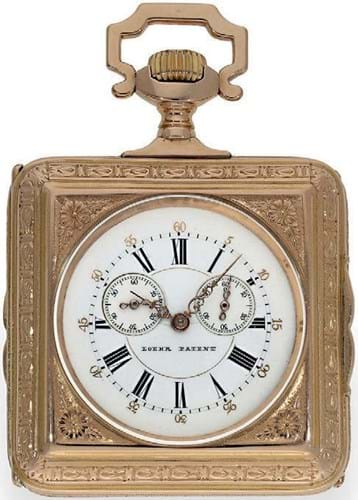
A rare late 19th century gold-cased self-winding watch by the Austrian company Loehr was knocked down at Cortrie for €8000 (£6960).
A fine example of a late 19th century self-winding watch by the Austrian manufacturer Loehr, who patented his ‘Perpetuelle’ mechanism in 1878, came up for sale at Cortrie. As a rule, these square watches have silver cases; examples in gold are much rarer. This explains the result of €8000 (£6960), twice the lower guide.

From the 1880s onwards, Mysterieuse watches by Armand Schwob & Frère were popular novelties. This example in a gold case was sold by Dr Crott for €9500 (£8260).
In 1881, Armand Schwob & Frère of La Chaux-de-Fonds patented its Mysterieuse or transparent watches, which became popular novelties. The cylinder movement was hidden in the rim of the case and the hands were driven, as if by magic, by glass discs.
Like the Loehr watches, the majority were in silver cases, but Dr Crott could offer a very rare example in gold, which sold to a bidder in Singapore for €9500 (£8260), slightly less than had been hoped for.
Patek Philippe variations
Collectors of watches by Patek Philippe watches always have an eye for unusual features such as the five-minute repetition coupled with a chronograph in a gold watch from 1880 which changed hands at Dr Crott for €12,000 (£10,430).
Worthy of note is a quarter repeater in an elaborately engraved case, signed by Patek & Cie, as the company was called in its early years. It sold at Dr Crott in Mannheim for the guide of €14,000 (£12,170).
An open face perpetual calendar gold watch from Patek Philippe, made in 1891, fulfilled its expectations by selling to a Swiss collector for a SFr24,000 (£21,240) at Antiquorum.
A similar but earlier Patek Philippe watch with extra complications was valued there at SFr26,000 (£23,010).
It went to a German collector who also purchased a watch with Papal connections. On the occasion of the 50th anniversary of his priesthood in 1887, Pope Leo XIII was presented with a gold watch by the maker Amiet in Besançon. In April it found its way to Antiquorum where it was knocked down for SFr35,000 (£30,970), considerably more than the estimate of SFr8000.

This gold minute-repeating hunter with seconde morte was manufactured by Louis Audemars for Michel Isakoff, the son of Tsar Nicholas. At Dr Crott the hammer fell at €25,000 (£21,740).
A gold minute-repeating hunter with seconde morte, manufactured by Louis Audemars in c.1910, had an equally impressive provenance.
It was made for Michel Isakoff, the son of Tsar Nicholas and instead of numerals the dial bore his name in Cyrillic letters. In 1913 he gave his watch to a certain Paul Souvray for services rendered to the court.
When it was last on the market in 2018, it brought $9000 at Sotheby’s in New York: this time around, a bidder in Singapore put up €25,000 (£21,740), more than double Dr Crott’s upper estimate.
There was a surprising result for a much younger gold perpetual calendar split-second pocket watch with minute-repeater, first sold by Audemars Piguet in 1964. The guide of SFr60,000-100,000 proved to be far too restrained: the bidding at Antiquorum ended at SFr150,000 (£132,740). A Swiss dealer had the deepest pockets.
Aesthetic appeal
Pocket watches are not only about precision timekeeping. While they too profited from the technical improvements achieved by their colleagues, other makers were more concerned with the aesthetic appeal of their timekeepers.
They had discovered the lucrative market in regions further afield, such as the Ottoman Empire and above all China.
From the second half of the 18th century, the existing trading connections with the Orient expanded, providing craftsmen in Great Britain and Geneva in particular with handsome incomes.
One of the pre-eminent pioneers in this area was William Ilbery of London who set up shop in Canton and was followed by colleagues from Switzerland. Although Ilbery’s watches were signed for London, many of the cases were produced in the enamel painting workshops in Geneva.
A watch with duplex escapement and the depiction of a Chinese woman in formal court costume just missed the guide when it sold for SFr59,000 (£52,210) at Antiquorum; a slightly earlier enamel watch with a rare gold movement reached the guide of SFr40,000 (£35,400), bid by a Swiss collector.
In the late 19th century, Edouard Juvet carried on the tradition of selling enamel watches to Chinese buyers. These are still as popular today, as the result of SFr52,000 (£46,020) in Geneva showed. The enamelled case showed a gallant scene with a couple in 18th century costume.
Surprisingly, numerous complex gold enamel pieces for the Chinese market were not signed by their makers.
This was also the case with an early 19th century Swiss double scent flask in the form of an urn capped by twin eagles’ head stoppers, with watch and visible balance.
It went over the odds at Sotheby’s in Geneva to sell for SFr75,000 (£66,370). It had an interesting provenance, having belonged to Gustav Bloch in Vienna, the brother-in-law of Adele Bloch-Bauer, made famous by two portraits by Gustav Klimt. The flask is closely related to two, somewhat more complicated pieces that were once part of the famous collection of King Farouk of Egypt.
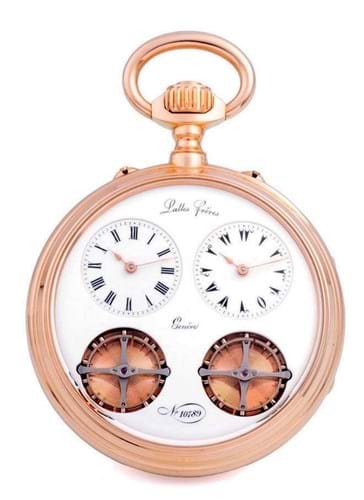
Fitted with two independent movements, this watch by Latte Frères was sold by Antiquorum for SFr90,000 (£79,650), more than four times the estimate.
Not all export watches were dominated by their decorative elements: major international interest was generated by a late-19th century gold watch with two independent movements which could be stopped at will.
Made for the Ottoman market by Latte Frères Genève in c.1880, it was expected to bring at least SFr20,000, but was knocked down to an Asian dealer at Antiquorum for SFr90,000 (£79,650).
£1 = €1.15/SFr1.13


